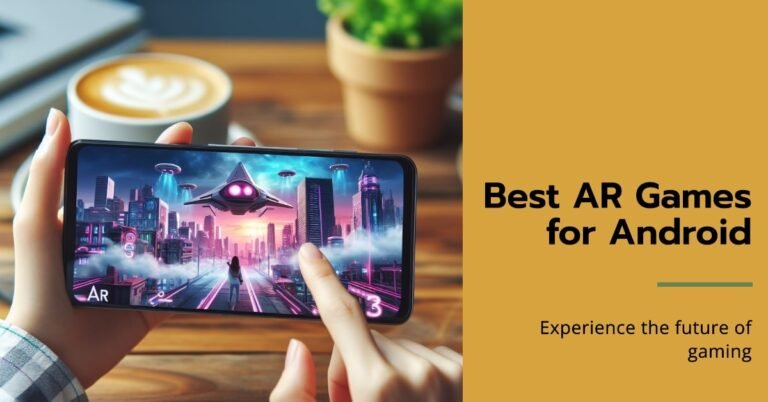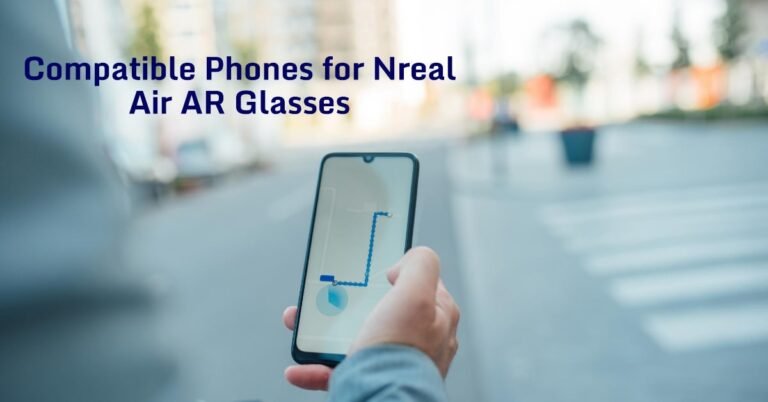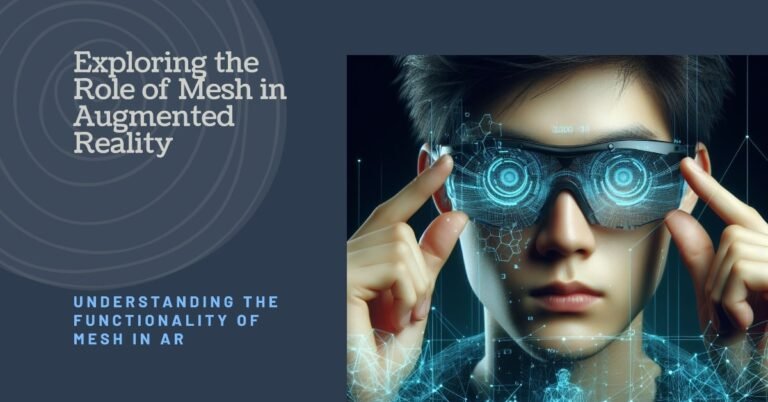How is AR Used in Education
Have you ever dreamt of dissecting a frog in biology class without harming a single creature? Or perhaps exploring the pyramids of Egypt from the comfort of your classroom? Augmented reality (AR) is making these experiences a reality, transforming education from a passive activity into an interactive and engaging adventure. Unlike virtual reality (VR) which completely immerses users in a computer-generated environment, AR overlays digital elements onto the real world.
Imagine holding a textbook that brings historical figures to life in 3D animation, or using a tablet to view the intricate workings of the human heart layered upon an anatomy chart. This is the magic of AR in education, and it’s fundamentally changing how students learn and retain information.
This article will be your one-stop guide to understanding How is AR Used in Education. We’ll explore the evolution of AR in the classroom, delve into practical applications that enhance learning experiences, and uncover the numerous benefits for students of all ages. We’ll also address the challenges and limitations, explore the exciting future of AR in education, and leave you feeling empowered to take the first steps toward integrating this revolutionary technology into your learning journey.
The Evolution of AR in Education
Early Applications and Innovations
The integration of Augmented Reality (AR) into education began with humble experiments and pilot programs. In the early stages, AR was primarily used to enhance traditional textbooks by overlaying digital information onto physical pages. These rudimentary applications aimed to make learning more interactive and engaging for students. For instance, a biology textbook might include AR features that allow students to see 3D models of human organs by simply scanning the page with a mobile device.
One of the first significant steps in AR education was the development of simple AR apps that could bring static images to life. These early innovations were often limited in scope but demonstrated the potential of AR to transform the learning experience. Teachers and students alike were fascinated by the ability to interact with digital content in the real world, which paved the way for more advanced applications.
How is AR Used in Education
Today, AR in education has evolved far beyond its early beginnings. Modern AR applications are sophisticated, offering a wide range of interactive and immersive experiences that cater to various educational needs. Here are some of the current trends and technologies in AR education:
1. Interactive Textbooks and 3D Models:
Modern interactive textbooks are a far cry from their predecessors. These textbooks use AR to provide students with 3D models and animations that can be manipulated and explored in real time. For example, a history textbook might include an AR feature that allows students to explore a 3D model of an ancient city, complete with detailed descriptions and historical facts.
2. Virtual Labs and Simulations:
Science education has greatly benefited from AR technology. Virtual labs and simulations allow students to conduct experiments and explore scientific concepts in a safe and controlled environment. AR can simulate chemical reactions, physics experiments, and even complex biological processes, providing a hands-on learning experience without the need for physical lab equipment.
3. AR Educational Platforms:
Several educational platforms have emerged that specifically focus on AR. For instance, Google Expeditions offers a range of AR experiences that can be used in the classroom to enhance lessons on various subjects. These platforms often come with lesson plans and activities designed to help teachers integrate AR into their curriculum effectively.
4. Augmented Reality Apps:
There are numerous AR apps available for both teachers and students. Apps like HP Reveal and Zappar allow users to create and view AR content easily. These apps can be used to create custom AR experiences tailored to specific lessons or projects, making it easier for teachers to incorporate AR into their teaching.
Examples of Popular AR Educational Platforms
Several AR platforms have gained popularity in the education sector due to their innovative features and ease of use. Here are a few examples:
1. Google Expeditions:
Google Expeditions is a comprehensive AR platform that offers immersive experiences across a wide range of subjects. Teachers can use the app to take students on virtual field trips to historical sites, museums, and natural habitats, providing an interactive learning experience that goes beyond the traditional classroom setting.
2. Merge Cube:
The Merge Cube is a physical object that, when viewed through an AR app, transforms into a variety of 3D objects and simulations. This tool is particularly popular in STEM education, as it allows students to interact with digital models of planets, molecules, and more. The Merge Cube makes abstract concepts tangible, helping students understand and retain complex information.
3. HP Reveal:
HP Reveal (formerly Aurasma) is an app that enables users to create their own AR content. Teachers can use HP Reveal to enhance lessons with custom AR experiences, such as interactive quizzes, 3D models, and multimedia presentations. The app is user-friendly and does not require advanced technical skills, making it accessible to educators at all levels.
Practical Applications of AR in Education
The use of Augmented Reality (AR) in education is rapidly growing, bringing about significant transformations in how students learn and interact with information. AR’s ability to overlay digital content onto the real world provides a dynamic and engaging way to enhance the learning experience. Let’s explore some of the practical applications of AR in education that are making waves today.
Enhanced Learning Experiences
- Interactive Textbooks and 3D Models: Interactive textbooks are among the most exciting applications of AR in education. These textbooks use AR to provide students with 3D models, animations, and interactive content that bring static images to life. For example, in a biology class, students can use AR to view and manipulate 3D models of human organs, exploring their structures and functions in detail. This hands-on approach makes learning more engaging and helps students understand complex concepts better.
- AR in Science Education: Virtual Labs and Simulations: Science education greatly benefits from AR technology. Virtual labs and simulations allow students to conduct experiments and explore scientific concepts in a safe and controlled environment. For instance, AR can simulate chemical reactions, physics experiments, and biological processes, providing an immersive learning experience without the need for physical lab equipment. This not only enhances understanding but also reduces costs and safety concerns associated with traditional labs.
Visualization of Complex Concepts
AR for Visualizing Abstract Concepts in Math and Physics: AR is particularly effective in subjects that involve abstract or complex concepts, such as mathematics and physics. For example, students can use AR to visualize geometric shapes in 3D, helping them understand spatial relationships and properties. In physics, AR can demonstrate the principles of motion, forces, and energy through interactive simulations. These visualizations make abstract concepts more tangible and easier to grasp.
To illustrate the impact of AR in education, let’s look at a few case studies:
- The Anatomy 4D App: This app was used in a high school biology class to teach students about the human body. By scanning images in their textbooks, students could view detailed 3D models of organs and systems, enhancing their understanding of anatomy.
- AR in a Middle School History Class: A middle school history teacher used AR to bring historical events to life. Students explored virtual reconstructions of historical sites and artifacts, increasing their engagement and understanding of historical contexts.
- Virtual Field Trips with Google Expeditions: A primary school used Google Expeditions to take students on virtual field trips to locations they couldn’t visit in person, such as the Great Barrier Reef and Mars. These immersive experiences sparked curiosity and excitement among students.
Interactive and Immersive Field Trips
Virtual Field Trips to Historical Sites, Museums, and Natural Habitats:
Field trips are an essential part of education, but they’re not always feasible due to cost or logistical constraints. AR offers a solution by providing virtual field trips that are both interactive and immersive. Students can explore historical sites, museums, and natural habitats without leaving the classroom. For example, an AR app might take students on a virtual tour of the Pyramids of Giza, complete with detailed historical information and 3D reconstructions. These experiences make learning more exciting and memorable.
Student Testimonials and Feedback:
Feedback from students who have experienced AR-enhanced field trips is overwhelmingly positive. Many students report that AR makes learning more enjoyable and helps them retain information better. Teachers also note that AR field trips can accommodate different learning styles and keep students engaged throughout the lesson.
Benefits of Using AR in Education
Augmented Reality (AR) is revolutionizing education by offering innovative ways to engage students and enhance their learning experiences. By overlaying digital information onto the real world, AR makes learning more interactive, immersive, and enjoyable. Let’s delve into the numerous benefits of using AR in education.
Increased Engagement and Motivation
One of the most significant advantages of AR in education is its ability to boost student engagement and motivation. Traditional teaching methods can sometimes struggle to capture students’ attention, especially with the rise of digital distractions. AR addresses this challenge by making learning more interactive and fun. Here’s how:
1. Interactive Learning Experiences:
AR transforms static lessons into dynamic, interactive experiences. For instance, instead of merely reading about the solar system in a textbook, students can use AR to explore 3D models of planets, moons, and asteroids. They can manipulate these models, observe their movements, and gain a deeper understanding of celestial mechanics.
2. Gamification of Learning:
AR can incorporate game-like elements into the learning process, such as quizzes, challenges, and rewards. This gamification makes learning more engaging and motivates students to participate actively. For example, an AR app for history might include a treasure hunt where students search for historical artifacts in a virtual museum.
3. Real-Time Feedback:
AR applications can provide immediate feedback on students’ performance. This instant feedback helps students correct mistakes, reinforce learning, and stay motivated. For instance, an AR math app can instantly show whether a student’s solution to a problem is correct, providing hints and explanations for any errors.
Personalized Learning Experiences
AR enables personalized learning, catering to the unique needs and preferences of each student. This customization enhances the effectiveness of education by allowing students to learn at their own pace and in their preferred style. Here are some ways AR facilitates personalized learning:
1. Adaptive Learning Paths:
AR can create adaptive learning paths that adjust based on students’ progress and performance. For example, an AR language learning app can tailor lessons to focus on areas where a student needs more practice, ensuring that each learner receives the appropriate level of challenge and support.
2. Catering to Different Learning Styles:
AR supports various learning styles, whether visual, auditory, kinesthetic, or a combination. Visual learners can benefit from 3D models and animations, while auditory learners can take advantage of integrated audio explanations. Kinesthetic learners can engage with hands-on AR activities, such as virtual dissections in biology.
3. Enhancing Special Education:
AR can be particularly beneficial for students with special educational needs. For example, AR can create sensory-friendly learning environments for students with autism, providing visual and auditory cues that help them understand and interact with the material. Additionally, AR can offer alternative communication methods for students with speech or language impairments.
Improved Retention and Understanding
The immersive nature of AR enhances retention and comprehension by engaging multiple senses and providing hands-on learning experiences. Here’s how AR contributes to better understanding and memory:
1. Visualizing Complex Concepts:
AR helps students visualize and understand complex concepts that are difficult to grasp through traditional methods. For instance, in chemistry, AR can demonstrate molecular structures and chemical reactions in 3D, making abstract concepts more tangible and easier to comprehend.
2. Reinforcing Learning through Interaction:
Interactive AR experiences reinforce learning by allowing students to actively participate in the educational process. Instead of passively receiving information, students can explore, experiment, and engage with the material. This active involvement enhances memory retention and understanding.
3. Comparative Studies:
Research has shown that AR can improve learning outcomes compared to traditional methods. Studies comparing AR-enhanced learning with conventional teaching techniques often find that students using AR perform better in tests, retain information longer, and demonstrate a deeper understanding of the material.
Challenges and Limitations of AR in Education
Technical and Infrastructure Issues
While the benefits of AR are clear, there are also challenges to consider. One of the primary obstacles is the technical and infrastructure requirements. Not all schools have the necessary hardware and network capabilities to support AR. This can limit the accessibility and effectiveness of AR in certain educational settings.
Cost and Budget Constraints
Another significant challenge is the cost. Implementing AR can be expensive, and many schools operate on tight budgets. However, there are potential solutions, such as seeking grants, partnering with technology companies, or exploring cost-effective AR solutions that can make this technology more accessible.
Teacher Training and Support
For AR to be effectively integrated into education, teachers need proper training and support. Many educators are not yet familiar with AR technology and how to use it in their teaching. Professional development programs and resources are essential to equip teachers with the skills and knowledge they need to leverage AR effectively in their classrooms.
Overcoming Educational Challenges with AR
1. Bridging Educational Gaps:
AR can help bridge educational gaps by providing high-quality learning resources to students in remote or underprivileged areas. For example, AR-enabled educational kits can bring advanced science labs to schools that lack the necessary infrastructure, offering students in rural areas the same opportunities as those in urban centers.
2. Making Learning Inclusive:
AR promotes inclusive education by catering to diverse learning needs and abilities. For instance, students with learning disabilities can benefit from AR’s multisensory approach, which offers alternative ways to engage with the material. Additionally, AR can support multilingual education by providing real-time translations and explanations in different languages.
3. Enhancing Teacher Effectiveness:
AR can also enhance teacher effectiveness by providing new tools and resources for instruction. Teachers can use AR to create more engaging lesson plans, offer interactive demonstrations, and assess student performance in real time. This technology empowers educators to deliver more impactful and personalized teaching.
Case Studies of Successful AR Implementations
To illustrate the impact of AR in education, let’s look at a few case studies of successful implementations:
1. The Anatomy 4D App:
In a high school biology class, the Anatomy 4D app was used to teach students about the human body. By scanning images in their textbooks, students could view detailed 3D models of organs and systems. This interactive experience made it easier for students to understand complex anatomical structures and their functions. The app received positive feedback from both students and teachers for its ability to make learning more engaging and effective.
2. AR in a Middle School History Class:
A middle school history teacher used AR to bring historical events to life. By incorporating AR into lessons on ancient civilizations, students could explore virtual reconstructions of historical sites and artifacts. This approach not only increased student engagement but also helped them develop a deeper understanding of the cultural and historical contexts of the events they were studying.
3. Virtual Field Trips with Google Expeditions:
A primary school used Google Expeditions to take students on virtual field trips to locations they could not visit in person. Through AR, students explored the Great Barrier Reef, the surface of Mars, and the inside of a human cell. These immersive experiences sparked curiosity and excitement among students, making them eager to learn more about the subjects covered in their virtual adventures.
Future of AR in Education
The future of Augmented Reality (AR) in education is brimming with possibilities that promise to revolutionize how we teach and learn. As technology continues to evolve, AR is set to become an integral part of the educational landscape, offering innovative solutions to enhance learning experiences, bridge educational gaps, and prepare students for the future. Let’s explore what the future holds for AR in education.
Emerging Technologies and Innovations
AR technology is rapidly advancing, with new developments and innovations continually emerging. Here are some key trends and technologies that will shape the future of AR in education:
1. Enhanced Hardware and Devices:
The future of AR in education will see the development of more advanced and accessible hardware. AR glasses, for instance, are becoming more affordable and user-friendly, providing immersive experiences without the need for smartphones or tablets. These devices will enable students to interact with AR content seamlessly in real time.
2. Integration with Artificial Intelligence (AI):
The integration of AR with AI will open up new possibilities for personalized and adaptive learning. AI algorithms can analyze students’ interactions with AR content, providing tailored feedback and adjusting the learning path based on individual performance. This combination will create highly personalized educational experiences that cater to each student’s unique needs.
3. Haptic Feedback and Sensory Integration:
Future AR applications will incorporate haptic feedback and other sensory integrations, allowing students to “feel” virtual objects. This multisensory approach will enhance the realism and immersion of AR experiences, making learning more engaging and memorable.
4. Advanced Content Creation Tools:
As AR technology matures, more sophisticated and user-friendly content creation tools will become available. Educators will be able to create custom AR experiences tailored to their curriculum, enabling them to design interactive lessons that meet their specific teaching objectives.
Potential for Global Impact
AR has the potential to make a significant global impact by addressing educational disparities and providing quality education to students worldwide. Here are some ways AR can contribute to global education:
1. Bridging Educational Gaps in Developing Regions:
In developing regions where access to quality education is limited, AR can play a crucial role in providing immersive and interactive learning experiences. AR applications can bring advanced educational resources to remote and underfunded schools, offering students in these areas the same opportunities as those in more developed regions.
2. Promoting Inclusive Education:
AR can support inclusive education by catering to diverse learning needs and abilities. For example, AR can provide alternative learning pathways for students with disabilities, offering visual, auditory, and kinesthetic learning options. Additionally, AR can support multilingual education by providing real-time translations and explanations in different languages.
3. Global Case Studies and Initiatives:
Several global initiatives are already leveraging AR to enhance education. For instance, the United Nations’ Sustainable Development Goals (SDGs) include a focus on quality education, and AR can contribute to achieving this goal by providing innovative and scalable educational solutions. Global case studies, such as AR-enabled learning programs in rural Africa and Asia, demonstrate the potential of AR to transform education on a global scale.
Vision for the Classroom of Tomorrow
The classroom of tomorrow will be a dynamic and interactive environment where AR plays a central role in the learning process. Here’s a vision of what the AR-enabled classroom might look like:
1. Immersive Learning Environments:
Imagine a classroom where students can explore ancient civilizations, travel to distant planets, or dive into the human bloodstream, all through AR. These immersive learning environments will make education more engaging and exciting, sparking curiosity and creativity in students.
2. Collaborative Learning Spaces:
AR will facilitate collaborative learning by enabling students to work together on virtual projects and simulations. For instance, students in different locations can collaborate on a virtual archaeology dig, uncovering artifacts and learning about history together in real-time.
3. Real-World Applications and Problem-Solving:
The AR-enabled classroom will emphasize real-world applications and problem-solving. Students can use AR to simulate real-life scenarios, such as managing a virtual eco-system, designing sustainable cities, or conducting virtual surgeries. These practical experiences will prepare students for future careers and challenges.
4. Expert Opinions and Futuristic Scenarios:
Experts in education and technology envision a future where AR is seamlessly integrated into the curriculum. According to a report by the World Economic Forum, AR and VR are among the top technologies set to transform education. Futuristic scenarios include AR-driven personalized tutoring, virtual internships, and global classroom collaborations, where students worldwide learn and innovate together.
FAQs – How is AR Used in Education
What is AR in education?
AR in education refers to the use of Augmented Reality technology to enhance learning experiences by overlaying digital content onto the real world, making lessons more interactive and immersive.
How does AR improve student engagement?
AR improves student engagement by making learning fun and interactive. Students are more likely to participate actively and retain information when they can interact with digital content meaningfully.
What are some examples of AR applications in education?
Examples of AR applications in education include interactive textbooks, 3D models, virtual labs, and virtual field trips. These tools help students visualize complex concepts and explore new environments without leaving the classroom.
What are the challenges of implementing AR in education?
Challenges of implementing AR in education include technical and infrastructure issues, cost and budget constraints, and the need for teacher training and support. Overcoming these challenges requires careful planning and resource allocation.
What is the future of AR in education?
The future of AR in education looks promising, with emerging technologies and innovations expanding its potential. AR is expected to become more integrated into classrooms, providing personalized and immersive learning experiences for students globally.
Conclusion
In conclusion, Augmented Reality (AR) is revolutionizing education by making learning more interactive, engaging, and effective. Despite the challenges, the benefits of AR in education are significant, and its potential for future impact is immense. As educators and institutions continue to explore and integrate AR into their teaching, the possibilities for enhancing student learning and achievement are limitless.
If you’re an educator or institution looking to explore AR in education, now is the time to start. Dive into the world of AR, experiment with different applications, and see firsthand how this technology can transform your teaching and your students’ learning experiences. For more insights and resources on AR in education, be sure to visit ARVRRealm.com.






